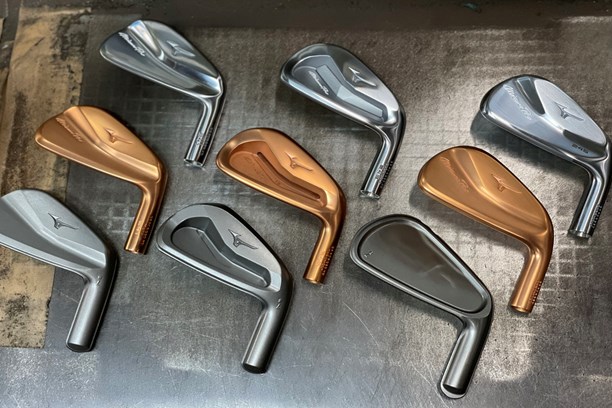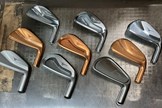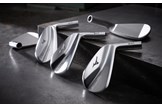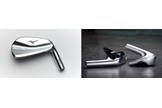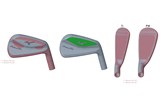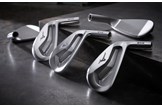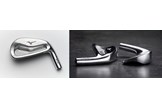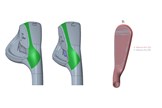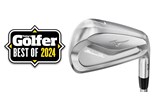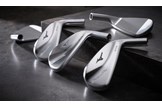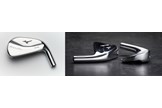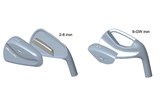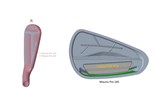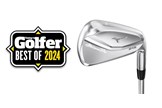Launch Monitor Tested: Mizuno Pro 241, 243 and 245 Iron Review
Last updated:
-
At a glance
- TG Rating
- Owner Rating
-
Pros
- Expect beautifully shaped heads.
- Guaranteed great feel and feedback.
- Lots of shaft options at zero upcharge.
-
Cons
- All the Mizuno Pro irons are seriously costly options in 2024.
What we say...
The Mizuno Pro 241, 243, and 245 irons are a muscle-back blade, tour cavity, and hollow body iron family designed for elite golfers.
Thanks to a greater depth of understanding between their CAD engineers and the forging house in Hiroshima, Japan, the Mizuno Pro 241, 243, and 245 irons challenge the boundaries of what can be created through the forging process. Mizuno has a massive forged iron heritage, so much so tons of golfers already feel they make some of the best golf irons available.
But, forging is a process where club heads are roughly stamped into shape in an age-old manner. And traditionally it’s a process that limits the head shape and geometry options that designers/engineers have at their disposal. But, Mizuno says by tying together their designers and craftsmen much more closely the brand has created the most sophisticated and precise irons they’ve ever made. Welcome to the Mizuno Pro 241, 243 and 245.
Everything you need to know about the Mizuno Pro 241 iron
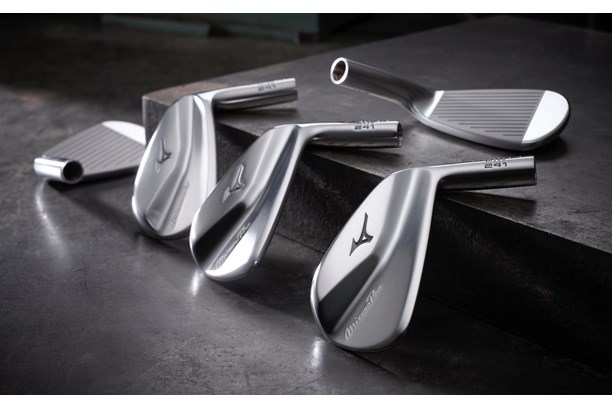
Pros
- Expect beautifully shaped heads.
- Guaranteed great feel and feedback.
- Lots of shaft options at zero upcharge.
Cons
- All the Mizuno Pro irons are seriously costly options in 2024.
| Stock shaft: | KBS Tour |
| Stock grip: | Golf Pride Z-Grip Cord |
| Construction: | One piece forged 1025E |
| Category: | Muscleback Blade |
| 7-iron loft: | 34° |
| Handicap guide: | 4 and below |
Mizuno may have a reputation for making some of the best forged irons available, but muscle-back blades are incredibly hard to update and improve. Thinking comes down to how moving away from traditionally accepted shapes means new will models never get played by the game’s best ball strikers. Yet the difference between a good and bad blade can literally be just a tenth of a millimeter.
Mizuno has been seen as the benchmark for muscle-back blades for decades. Greats like Tiger Woods, Nick Faldo, Sandy Lyle, and Luke Donald have all played the brand’s most iconic blades. With each generation, Mizuno makes tiny changes and amends which they reckon help empower pure ball strikers and serial shot shapers across the globe.
The new Pro 241 is one-piece forged from 1025E steel. The head is squashed under greater pressure lower in the blade to compact the grain structure, giving an improved feel where shots are typically hit. Like all Mizuno Pro iron models, the 241 has a soft copper underlay beneath its nickel chrome finish. The brand insists this gives exactly the same feel as their most iconic irons which were produced in the 1980’s.
There’s never a headline story lurking behind a new set of blades, but the 241 benefits from more centered mass behind the hitting zone. The update delivers a longer, softer impact sensation preferred by Mizuno’s tour staff. The blade is also progressively more tapered from high to low. So, a wider upper portion in the short irons delivers a lower more penetrating ball flight, while narrower long irons are slightly easier to flight.
Blade connoisseurs might just notice the long irons are slightly smaller and thinner than the previous Pro 241’s, where the mid and scoring irons are visibly more compact.
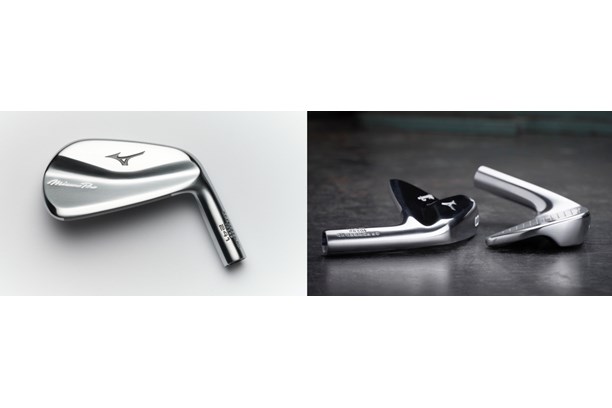
Mizuno Pro 241 iron
RRP: £200 $TBC per club
Stock shaft: KBS Tour
Stock grip: Golf Pride Z-Grip Cord
Construction: One piece forged 1025E
Category: Muscleback Blade
7-iron loft: 34°
Handicap guide: 4 and below
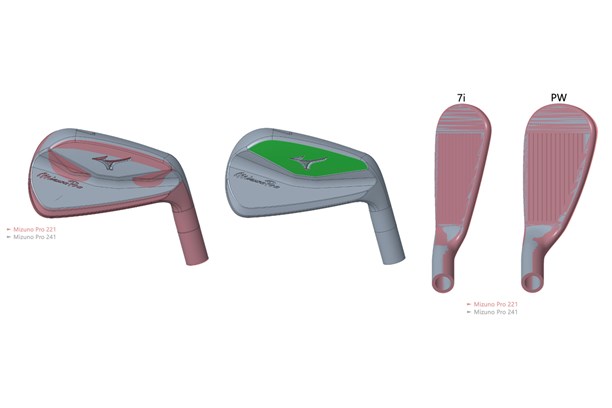
Verdict: Mizuno Pro 241 iron
Mizuno has a massive reputation for making great forged muscleback blades, but I’d hazard a guess not many previous generations have come in at £1400 for a seven-piece set. As aspirational and lovely as the 241’s are £200 a club is a very punchy price for Mizuno blades.
There will be Mizuno fans and loyalists out there that swear the 241 is the best feeling blade on the market, our test pro though found it very difficult to definitively say he felt any difference between this model and the majority of the other 11 muscleback blades he hit this year. That’s not to knock Mizuno but just to highlight the hype that surrounds feel out there in the marketplace.
It’s worth pointing out that the Pro 241 created the least amount of backspin within our 2024 muscleback blade test, while other metrics were pretty much bang on test averages across the board. To me that highlights the need to get properly fit for, and choose shafts that aren’t going to be lower spinning, which ultimately would make the 241 harder to stop on slick hard green surfaces. Especially as the whole reason for turning to a model of this ilk is ultimate precision and control.
Data comparison: How does the Mizuno Pro 241 compare to leading competitor muscleback blades?
| Iron | 7-Iron Loft | Ball Speed | Launch Angle | Backspin | Peak Height | Descent Angle | Carry Distance | Carry Distance Drop Off | Shot Area |
| Ping Blueprint T | 33° | 120.7 MPH (1) | 16.6° | 5630 RPM | 30 YDS | 44.1° | 178 YDS (1) | 8 YDS (T3) | 98.4 SQ YDS (3) |
| PXG 0317 ST | 33° | 118.9 MPH | 15.4° | 5619 RPM | 27 YDS | 42° | 174 YDS (T2) | 9 YDS | 184.5 SQ YDS |
| Wilson Staff Model Blade | 34° | 118.7 MPH | 16.9° | 5661 RPM | 30 YDS | 43.9° | 174 YDS (T2) | 14 YDS | 312.2 SQ YDS |
| Sub 70 639 MB | 32° | 119.3 MPH (3) | 14.8° | 5844 RPM | 26 YDS | 41.6° | 174 YDS (T2) | 9 YDS | 235.8 SQ YDS |
| Cobra King MB | 34° | 118.9 MPH | 17.1° | 6225 RPM | 31 YDS | 45° | 172 YDS | 8 YDS (T3) | 224 SQ YDS |
| Mizuno Pro 241 | 34° | 117.3 MPH | 17.6° | 5547 RPM | 30 YDS | 44.3° | 171 YDS | 11 YDS | 218.9 SQ YDS |
| Vega VMB | 31° | 119.5 MPH (2) | 15.3° | 6177 RPM | 28 YDS | 43.4° | 171 YDS | 5 YDS (1) | 50.5 SQ YDS (1) |
| TaylorMade P7MB | 34° | 118.5 MPH | 16.2° | 6490 RPM | 29 YDS | 44.1° | 170 YDS | 12 YDS | 235.2 SQ YDS |
| Callaway Apex 24 MB | 34° | 115.9 MPH | 17° | 6029 RPM | 29 YDS | 43.8° | 167 YDS | 18 YDS | 433.8 SQ YDS |
| Srixon Z-Forged | 33° | 116.7 MPH | 16.5° | 6123 RPM | 28 YDS | 43.6° | 167 YDS | 21 YDS | 588 SQ YDS |
| Titleist 620 MB | 35° | 115.6 MPH | 17.5° | 6362 RPM | 29 YDS | 44.7° | 165 YDS | 13 YDS | 318.5 SQ YDS |
| Takomo 301 MB | 34° | 115.9 MPH | 16.7° | 6637 RPM | 29 YDS | 44.7° | 163 YDS | 7 YDS (2) | 90.3 SQ YDS (2) |
| Average | 118 MPH | 16.5° | 6028.7 RPM | 28.8 YDS | 43.8° | 170.5 YDS | 11.25 YDS | 249.2 SQ YDS |
What Mizuno says about the Pro 241 iron
Mizuno Director of R&D, David Llewellyn
“With a muscle-back, the gains are in the details. The key to a visually appealing topline might be a fraction of a millimeter, which can be lost or created in manufacturing. Working hand in hand with our forging plant for so many years allowed us to be incredibly precise in the engineering and craftsman’s stages of the Mizuno Pro 241”.
Mizuno Product Director, Chris Voshall
“The muscle-back has re-established itself as Mizuno’s most played iron model on tour over the last couple of seasons, so we gave our professional ambassadors a more involved role in the development of the Mizuno Pro 241. You can see their influence most in the narrower top-line and compact scoring irons”.
Everything you need to know about the Mizuno Pro 243 iron
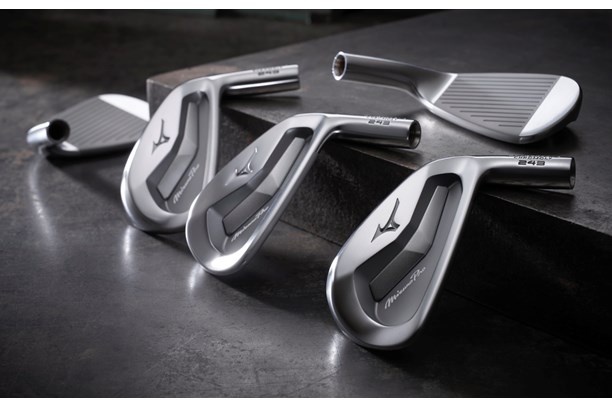
| Stock shaft: | Dynamic Gold Mid 115 |
| Stock grip: | Golf Pride MCC |
| Construction: | One piece forged 4120 Chromoly (4 – 7 iron), One piece forged 1025E (8 – GW) |
| Category: | Tour Cavity Back/Players’ Iron |
| 7-iron loft: | 32° |
| Handicap guide: | 6 and below |
Tour irons have changed dramatically over the last five years, almost becoming a category positioned above the best players’ irons. Today much less emphasis is put on playing matched sets of irons. With the shift being so significant 80% of PGA Tour players now use mixed/combo sets.
Focus has turned instead to having the right club and construction to produce the desired ball flight (including speed launch angle, shot height, and descent angle) for each distance gap in a golfers bag. Some competitors create two or three solutions for this market, but thanks to various multi-material constructions, the Mizuno Pro 243 addresses the issues most often raised around elite player irons all within a single set.
The Pro 243 is very much the modern tour iron. Mizuno believes the model is a manufacturing masterpiece – more compact and precise than its predecessor, yet faster and more satisfying at impact too. Like most great tour irons the Pro 243 is stamped into shape from a single piece of steel.
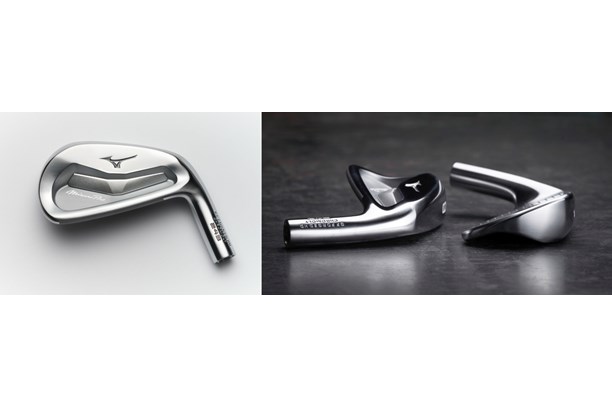
Mizuno though uses springier, faster 4120 chromoly steel from 4-7 iron, and switches to the brand’s legendary 1025E mild carbon from 8-GW. A move that ensures golfers get higher launch and faster ball speeds for longer approaches along with more feel and control from closer in.
A new wrap-around sole grind reduces sole width visually. Bounce angles have increased slightly too (1° in the long irons, 2° in the scoring clubs), both of which help improve turf interaction. Golfers can also expect a reduced topline thickness and slightly shorter blade length than the previous model. New shaping also produces vibration patterns closely matched to a soft muscle-back blade.
Be under no illusion though this cavity back is not a forgiving option. Like the Titleist T100, TaylorMade P7MC, and Callaway Apex 24 CB it’s never been designed that way.
We’ve seen internal player testing results on the Pro 243, and while the 7-iron data looks very similar to previous models, the 5-iron produced 0.5mph more ball speed, which equates to a 1.6-yard carry distance gain. So, don’t be fooled into thinking this is a distance iron option.
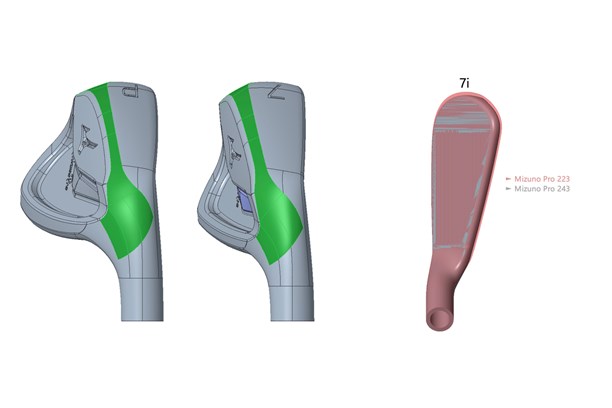
Mizuno Pro 243 iron
RRP: £215 $TBC per club
Stock shaft: Dynamic Gold Mid 115
Stock grip: Golf Pride MCC
Construction: One piece forged 4120 Chromoly (4 – 7 iron), One-piece forged 1025E (8 – GW)
Category: Tour Cavity Back/Players’ Iron
7-iron loft: 32°
Handicap guide: 6 and below
Video: How does the Mizuno Pro 243 compare to other leading 2024 Players’ Irons?
Verdict: Mizuno Pro 243 iron
No best players’ iron feature would be complete without a set of Mizuno’s, and today thanks to owning the JPX and Pro franchises the company have two bites at the cherry.
I’m no Mizuno knocker but there’s no getting away from how the brand’s iron launches over the last few years have become a bit predictable. Within the JPX family, I’ve seen the 919, 921, and 923 families cover off the course of the last six years. We’re also now into the 2nd generation of Pro irons which by the time they’re retired will have spanned an additional 4 years too.
Hand on heart if I bought an original set of either franchise, I’d really struggle to say any subsequent generation, bar the introduction of springy chromoly steel, has been a huge step forward in terms of performance. That’s not a slight on the most recent updates but if you own previous models I reckon you don’t have to keep updating to the latest and greatest. However, if you’re new to Mizuno or just looking for a great set of players’ irons in 2024 the Pro 243s represent a very solid choice.
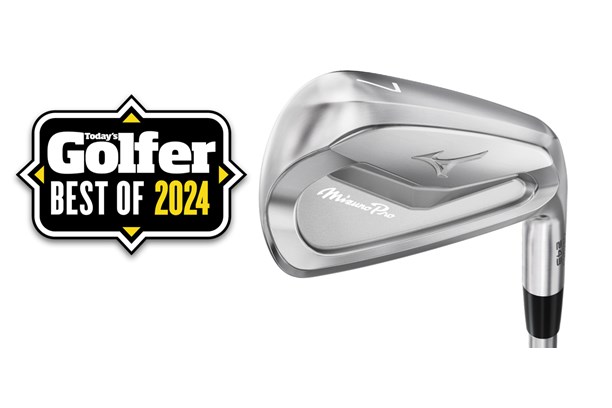
Cast your eye over our test data and you won’t find the Mizuno Pro 243 on the podium for any single metric. Yet our test pro was adamant the model felt quick and powerful (it produced a faster-than-average ball speed) and offered the ball flight, control and look he wants from a forged cavity back tour-level iron. To back up his thinking, compared to the 2° weaker Mizuno JPX923 Tour iron the Pro 243 hit shots higher, with a steeper decent angle and additional spin, features lots of decent players will appreciate. Factor in top-drawer levels of feel and you have an iron that’s well worth a position among our favorite five players’ irons of 2024.
If you’re looking at this category in 2024 it’s really hard to make a bad choice, as there are so many good irons within the players’ iron arena. I’d be drawn to the Mizuno Pro 243 not only because it’s a very solid performer across the board, but because there’s also a two life expectancy ahead of it. If you’re the type of person though who likes to have the very latest model in their bag, bear in mind the JPX family is also due for replacement later this summer.
Data comparison: How does the Mizuno Pro 243 iron compare to leading competitor Players’ Irons?
| Iron | 7-Iron Loft | Ball Speed | Launch Angle | Backspin | Height | Descent Angle | Carry Distance | Carry Distance Drop Off | Shot Area |
| PXG 0317 T | 32° | 125 MPH (1) | 15.6° | 5343 RPM | 32 YDS | 45.1° | 182 YDS (1) | 6 YDS | 118.2 SQ YDS |
| PXG 0317 CB | 33° | 122.8 MPH | 16.6° | 5568 RPM | 32 YDS | 45.7° | 179 YDS (T2) | 7 YDS | 142.1 SQ YDS |
| Vega VDC | 31° | 124.4 MPH (2) | 14.8° | 5703 RPM | 30 YDS | 44.4° | 179 YDS (T2) | 8 YDS | 236.8 SQ YDS |
| Srixon ZX7 MK II | 32° | 122.9 MPH (3) | 16.7° | 5757 RPM | 32 YDS | 46.1° | 178 YDS | 7 YDS | 57.4 SQ YDS |
| Sub 70 659 CB | 32° | 122.8 MPH | 15.3° | 5683 RPM | 30 YDS | 44.2° | 178 YDS | 8 YDS | 70.4 SQ YDS |
| More MOD 1 | 32° | 121.5 MPH | 15.9° | 5370 RPM | 30 YDS | 44.1° | 178 YDS | 2 YDS (1) | 48.4 SQ YDS (2) |
| Ping Blueprint S | 33° | 121.3 MPH | 16.7° | 5498 RPM | 31 YDS | 45.1° | 177 YDS | 9 YDS | 188.1 SQ YDS |
| Titleist T150 | 32° | 122.6 MPH | 17.5° | 5686 RPM | 34 YDS | 46.8° | 177 YDS | 4 YDS (2) | 53.6 SQ YDS (3) |
| Takomo 201 | 32° | 122.6 MPH | 15.7° | 6070 RPM | 31 YDS | 45° | 176 YDS | 9 YDS | 119.7 SQ YDS |
| Cobra King Tour | 32° | 120.9 MPH | 15.4° | 5534 RPM | 29 YDS | 43.1° | 176 YDS | 9 YDS | 253.8 SQ YDS |
| TaylorMade P770 | 33° | 122.3 MPH | 17.8° | 6143 RPM | 34 YDS | 47.5° | 175 YDS | 9 YDS | 200.7 SQ YDS |
| Mizuno JPX923 Tour | 34° | 121 MPH | 16.2° | 5704 RPM | 30 YDS | 44.6° | 175 YDS | 9 YDS | 171 SQ YDS |
| Vega VSC | 31° | 121.7 MPH | 15.2° | 5943 RPM | 29 YDS | 43.8° | 175 YDS | 14 YDS | 387.8 SQ YDS |
| Callaway Apex 24 Pro | 33° | 122.4 MPH | 16.2° | 6026 RPM | 27 YDS | 43.3° | 174 YDS | 7 YDS | 128.1 SQ YDS |
| Callaway Apex TCB | 34° | 121.9 MPH | 16.6° | 5189 RPM | 32 YDS | 46.1° | 174 YDS | 5 YDS (3) | 46 SQ YDS (1) |
| Mizuno Pro 243 | 32° | 122.2 MPH | 16.6° | 6035 RPM | 32 YDS | 46.3° | 174 YDS | 18 YDS | 387 SQ YDS |
| Ping i230 | 33° | 121.3 MPH | 16.4° | 5821 RPM | 31 YDS | 45.7° | 173 YDS | 19 YDS | 248.9 SQ YDS |
| Sub 70 639 CB | 32° | 122.3 MPH | 15.4° | 6584 RPM | 30 YDS | 45.4° | 173 YDS | 13 YDS | 266.5 SQ YDS |
| Callaway Apex 24 CB | 34° | 120.6 MPH | 16.7° | 6235 RPM | 31 YDS | 46.2° | 170 YDS | 9 YDS | 151.2 SQ YDS |
| Takomo 301 CB | 34° | 120 MPH | 17.3° | 6410 RPM | 32 YDS | 46.4° | 170 YDS | 7 YDS | 152.6 SQ YDS |
| TaylorMade P7MC | 34° | 119.5 MPH | 18° | 6226 RPM | 33 YDS | 47.2° | 169 YDS | 11 YDS | 135.3 SQ YDS |
| Wilson Staff Model CB | 34° | 118.6 MPH | 16.3° | 6221 RPM | 29 YDS | 44.8° | 169 YDS | 6 YDS | 76.8 SQ YDS |
| Titleist T100 | 34° | 118.1 MPH | 17.3° | 5677 RPM | 31 YDS | 45.4° | 169 YDS | 8 YDS | 107.2 SQ YDS |
| Ben Hogan PTX Tour | 33.5° | 117.9 MPH | 16° | 5767 RPM | 28 YDS | 43.5° | 169 YDS | 11 YDS | 335.5 SQ YDS |
| Titleist 620 CB | 34° | 117.9 MPH | 17.9° | 6127 RPM | 32 YDS | 46.5° | 167 YDS | 13 YDS | 274.3 SQ YDS |
| Average | 121.4 MPH | 16.4° | 5853 RPM | 30.9 YDS | 45.3° | 174.2 YDS | 9.1 YDS | 174.3 SQ YDS |
What Mizuno says about the Pro 243 iron
Mizuno Director of R&D, David Llewellyn
“The Mizuno Pro 243 is the model that’s advanced the most, mainly due to evolution on the manufacturing side. It’s one thing for the R&D team to design a thinner face iron with stronger materials in the CAD world – but something else to have it Grain Flow Forged to those specifications and strength requirements”.
Mizuno Product Director, Chris Voshall
“The Mizuno Pro 243 looks much more compact than its predecessor, even though the performance has stepped up. The long and mid-irons are flying far enough, that we’ve had to modernize the lofts in the scoring irons. Mizuno Pro isn’t stuck in tradition – we’re led by performance above what might be expected historically”
Everything you need to know about the Mizuno Pro 245 iron
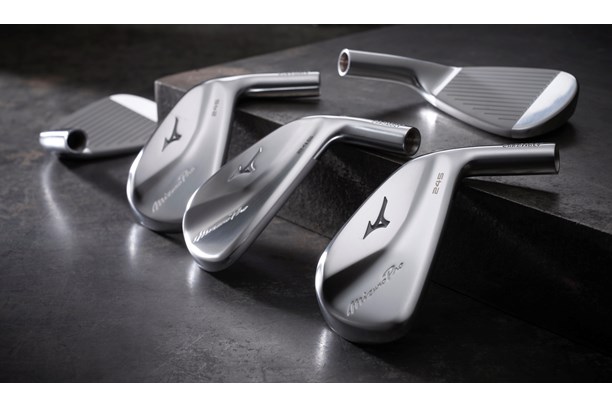
| Stock shaft: | Dynamic Gold Mid 100 |
| Stock grip: | Golf Pride MCC |
| Construction: | Hollow body created from multiple materials |
| 7-iron loft: | 30° |
| Handicap guide: | 10 and below |
The Pro 245 iron is a hugely complex model to create. From 2 – 8 iron the face and neck are created from springy Grain Flow Forged 4135 Chromoly steel. Inside a suspended 46g tungsten weight (there was 30g in the Pro 225) aids launch (except the 8-iron), while to create the hollow body a 431 stainless steel section is laser welded onto the back.
From 9 – GW each face and body is created from Grain Flow Forged 1025E which ups feel and feedback in the shorter scoring clubs. A cap of 17-4 stainless steel is then welded behind the hitting zone to create a partial hollow body construction. A more complex set of hollow body irons, that don’t benefit from CNC Milling, you won’t find on the market. A point that demonstrates exactly why Mizuno talks up their club engineers and forging facility working much more closely. These three new models really do represent a whole new era of forging for the company.
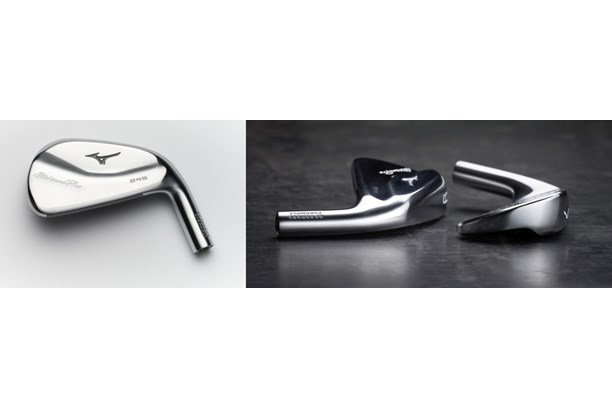
Through internal player testing Mizuno has compared the new Pro 245 to the previous Pro 225, and golfers can expect to see more ball speed and carry. Gains come through from both ends of the set rather than the 7-iron in the middle.
On paper, the numbers equate to 2.5 mph of additional ball speed with a wedge, and 0.7 mph with a 4-iron, which deliver 3.7 and 3.1 yards extra carry distance respectively. But, remember the best players’ distance iron category is incredibly competitive, so buying decisions often come down to launch monitor numbers, which makes any gain well worth having.
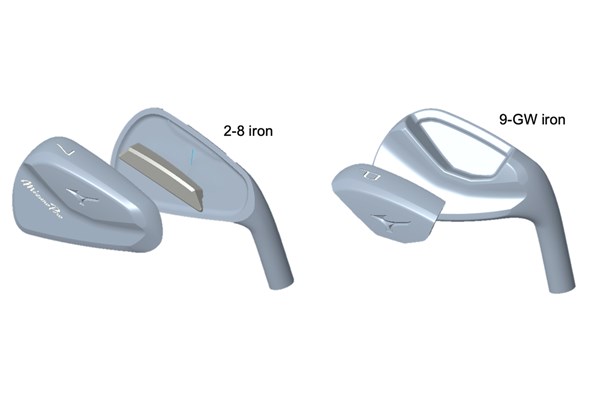
Mizuno Pro 245 iron
RRP: £230 $TBC per club
Stock shaft: Dynamic Gold Mid 100
Stock grip: Golf Pride MCC
Construction: Hollow body created from multiple materials
7-iron loft: 30°
Handicap guide: 10 and below
Video: How does the Mizuno Pro 245 compare to other leading 2024 Players’ Distance irons?
Verdict: Mizuno Pro 245 iron
Even though the new fast-face Mizuno Pro 245 gave up 4.8mph of ball speed and 13 yards of 7-iron carry distance compared to our longest players distance iron this year (the Mizuno JPX923 Hot Metal Pro) our test pro was adamant this was the model he’d want in his bag.
His thinking came down to loving the punchy feel of the Pro, and how its slightly weaker 7-iron loft gave him the hanging rather than boring ball flight he prefers. Our test data utterly supports what his eyes and gut feel were telling him. Unless you specifically want to lower ball flight with the JPX923 Hot Metal Pro, the 245 launched and flew higher (1.5° and 1 yard respectively) span 600 RPM more, and hit the green at a 1.8° steeper descent angle, all numbers that will help golfers score better on the golf course. Ok, the JPX was 13 yards longer (with a 7-iron) but its dispersion/shot area was also 63.4% bigger which is a huge price to pay in the area of the bag most golfers crave accuracy.

Tons of golfers will be weighing up a choice between the Pro 245 and other leading hollow body irons like the TaylorMade P790, Titleist T200, Ping i525, and PXG 0311 P GEN6 this year. My advice to anyone trying to fathom this conundrum is to go and try them side by side. Very quickly you’ll narrow your choice to a couple of favorite options based on head shape, feel, and ball flight traits.
From there be led by stock shaft options, the ability to tailor lofts to your personal ball flight requirements (you can do this with the TaylorMade P790), and if you need lighter, heavier, longer, or shorter irons who gives the opportunity to try these without moving the center of gravity away from center face (PXG do). All in you can’t make a bad choice, these are great irons, hence why they all feature on my shortlist of top-performing Players’ Distance Irons in 2024.
Data comparison: How does the Mizuno Pro 245 compare to leading competitor Players’ Distance Irons?
| Iron | 7-Iron Loft | Ball Speed | Launch Angle | Backspin | Height | Descent Angle | Carry Distance | Carry Distance Drop Off | Shot Area |
| Mizuno JPX923 Hot Metal Pro | 28.5° | 124.1 MPH (1) | 14.6° | 4881 RPM | 28 YDS | 41.8° | 186 YDS (1) | 22 YDS | 741.4 SQ YDS |
| Srixon ZX5 MK II | 31° | 122.8 MPH (3) | 15.8° | 5292 RPM | 30 YDS | 44° | 181 YDS (T2) | 18 YDS | 392.4 SQ YDS |
| Callaway Paradym | 29° | 123 MPH (2) | 14.2° | 5120 RPM | 27 YDS | 41.5° | 181 YDS (T2) | 15 YDS | 360 SQ YDS |
| Mizuno JPX923 Forged | 30° | 122.4 MPH | 14.5° | 5117 RPM | 27 YDS | 41.8° | 180 YDS | 7 YDS (1) | 210 SQ YDS |
| PXG 0311 P GEN 6 | 30° | 122.2 MPH | 14.6° | 5520 RPM | 28 YDS | 42.6° | 178 YDS | 10 YDS | 199 SQ YDS |
| Vega Mizar Tour | 30° | 122.3 MPH | 13.5° | 5381 RPM | 26 YDS | 40.8° | 178 YDS | 13 YDS | 360.1 SQ YDS |
| Sub 70 699 Pro | 30° | 121.8 MPH | 14.9° | 5349 RPM | 28 YDS | 42.6° | 178 YDS | 10 YDS | 166 SQ YDS (1) |
| Yonex Ezone CB702 | 31° | 122.6 MPH | 15.6° | 5820 RPM | 30 YDS | 44.4° | 177 YDS | 23 YDS | 533.6 SQ YDS |
| TaylorMade P790 | 30.5° | 121.6 MPH | 15.1° | 5932 RPM | 29 YDS | 43.7° | 175 YDS | 8 YDS (T2) | 180.8 SQ YDS (2) |
| Wilson Dynapower Forged | 30.5° | 120.8 MPH | 13.9° | 5482 RPM | 26 YDS | 41.1° | 175 YDS | 9 YDS | 188.1 SQ YDS (3) |
| Ping i525 | 30.5° | 120 MPH | 15° | 5666 RPM | 28 YDS | 42.7° | 173 YDS | 11 YDS | 217.8 SQ YDS |
| Titleist T200 | 30.5° | 119.7 MPH | 15.4° | 5760 RPM | 28 YDS | 43.3° | 173 YDS | 13 YDS | 331.5 SQ YDS |
| Cobra Forged Tec | 29.5° | 119.4 MPH | 14.7° | 5558 RPM | 27 YDS | 41.9° | 173 YDS | 20 YDS | 612 SQ YDS |
| Mizuno Pro 245 | 30° | 119.3 MPH | 16.1° | 5481 RPM | 29 YDS | 43.6° | 173 YDS | 14 YDS | 271.6 SQ YDS |
| Takomo 101 T | 32° | 116.7 MPH | 16° | 6383 RPM | 28 YDS | 43.9° | 165 YDS | 8 YDS (T2) | 203.2 SQ YDS |
| Average | 121.2 MPH | 14.9° | 5516.1 RPM | 27.9 YDS | 42.6° | 176.4 YDS | 13.4 YDS | 331.2 SQ YDS |
What Mizuno says about the Pro 245 iron
Mizuno Director of R&D, David Llewellyn
“There’s so much to the Mizuno Pro 245 for an iron of its size and shape. A multi-piece Grain Flow Forged Chromoly construction, suspended tungsten weight, and multi-thickness face. Impossible with Mizuno evolving its Grain Flow Forging process in Hiroshima. It takes a depth of manufacturing experience to push the envelope this far”.
Mizuno Product Director, Chris Voshall
“There are some impressive ball speed gains in the Mizuno Pro 245 considering we’ve slimmed it down – especially in the longer irons. The biggest challenge for people now is telling this iron apart from the one-piece 241 muscle-back”.
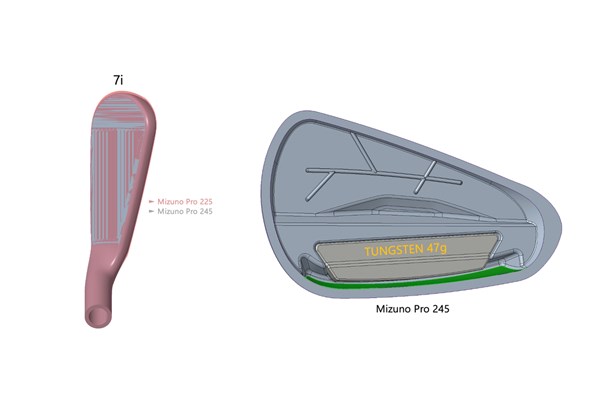
About the author

Simon Daddow – Equipment Editor
Simon Daddow is the Equipment Editor for Today’s Golfer. Having tested and played more than 10,000 clubs in his life, what he doesn’t know about golf clubs isn’t worth knowing.
He’s a specialist in all things metal having spent a large part of his career as a golf club maker and product development manager, and has worked in the golf industry for more than 30 years.
You can contact Simon via email and follow him on Twitter for loads more golf equipment insight.
Product Information
Mizuno Pro 241 iron
RRP: £200 $TBC per club
Stock shaft: KBS Tour
Stock grip: Golf Pride Z-Grip Cord
Construction: One piece forged 1025E
Category: Muscleback Blade
7-iron loft: 34°
Handicap guide: 4 and below
Mizuno Pro 243 iron
RRP: £215 $TBC per club
Stock shaft: Dynamic Gold Mid 115
Stock grip: Golf Pride MCC
Construction: One piece forged 4120 Chromoly (4 – 7 iron), One piece forged 1025E (8 – GW)
Category: Tour Cavity Back/Players’ Iron
7-iron loft: 32°
Handicap guide: 6 and below
Mizuno Pro 245 iron
RRP: £230 $TBC per club
Stock shaft: Dynamic Gold Mid 100
Stock grip: Golf Pride MCC
Construction: Hollow body created from multiple materials
7-iron loft: 30°
Handicap guide: 10 and below
